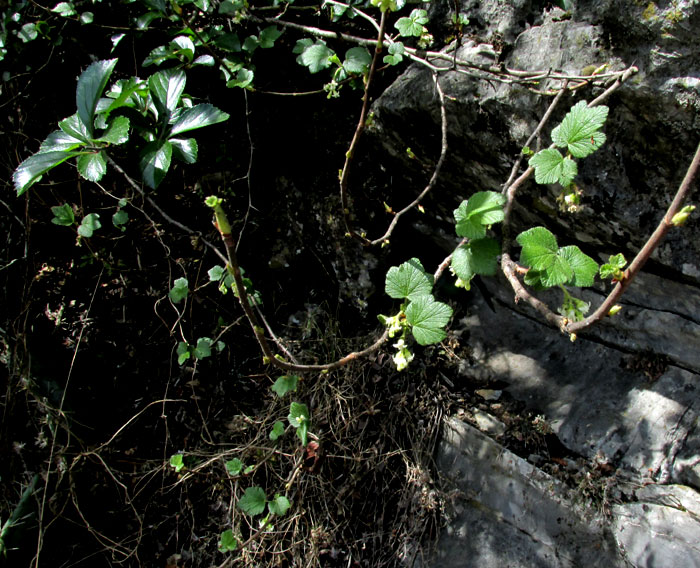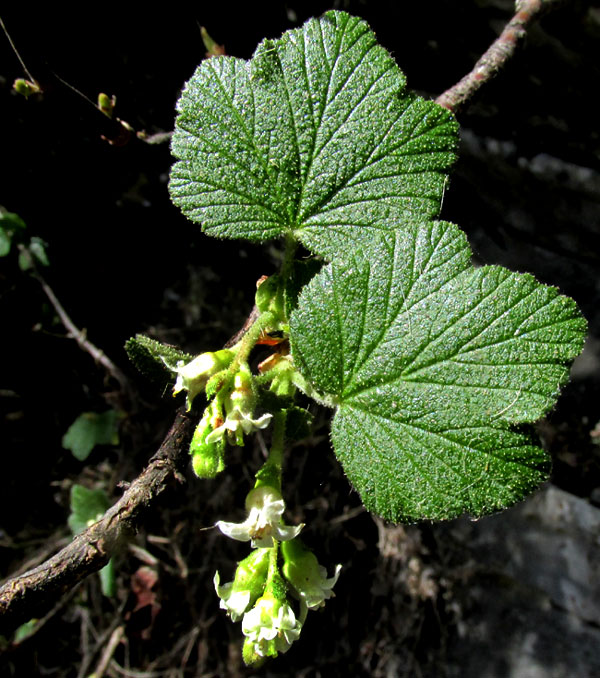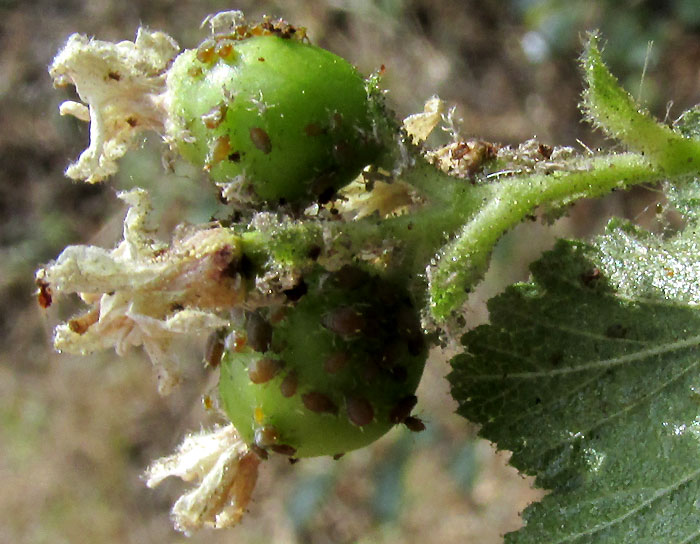Excerpts from Jim Conrad's
Naturalist Newsletter
entry from field notes dated April 17, 2022, taken in disturbed/reforesting borderline cloudforest within 1km of Valle de los Fantasmas, elevation ±2,320m (7600 ft), with limestone bedrock; about 40kms (24 miles), straight-line, ESE of San Luis Potosí, San Luis Potosí state, MÉXICO, (N22.06°, W100.62°)
A FLOWERING CURRANT

Beside the main highway between San Luis Potosí city and Río Verde, the spindly bush shown above hung down the face of an old roadcut through limestone. The bush was flowering, shown below:

With such roundish, maple-like leaves with sawtoothed margins, Northerners who pay attention to plants may recognize a gooseberry or currant bush here, genus Ribes. Often there's confusion about the difference between gooseberries and currants. Gooseberry plant stems bear spines and prickles and their flowers' stems, or pedicels, lack joints, while currant stems lack spines but the flowers' pedicels are jointed. You can see that these stems have no spines, so our bush is a currant.

The above flower shows a distinctive feature of Ribes blossoms: There's a cup- or saucer-shaped, crown-like appendage arising inside the corolla, at the base of the petals. Technically that's a free part of the "hypanthium," which most flowers don't have, but is seen in the big Rose Family and several others. Hypanthia surround or are fused to the ovary. In the picture below, the hypanthia are fused to the fast-expanding ovaries they surround.

The immature, green fruits look a little ratty because they're covered with dark-green aphids sucking sap from the fruit, and white exoskeletons shed by the aphids as they grew. Notice that the aphids mostly avoid the green developing leaves and stem, probably because the new leaves and stems bear sticky, glistening glands among the hairs, and the aphids might get stuck there. On this bush leaf undersurfaces lack glands, but the petioles and bases of the main veins bear many of them, maybe explaining why the leaf undersurfaces seem aphid free. The Flora del Bajío speaks of this species' leaf undersurfaces as having drops of resin dispersed over all the surface, so apparently that explains what's shown below:

The Flora of North America, usually all no-nonsense, almost waxes poetic about glands in the genus Ribes, saying that they "... may give the flowers or berries a bejeweled appearance." In this particular species, however, instead of the berry-type fruits being bejeweled, they're be-aphided.
The Flora of North America also tells us that the genus Ribes is home to about 160 species, of which 53 are documented for North America. In our part of arid, upland central Mexico about five are known, and this one is RIBES AFFINE. Since Ribes affine is endemic from upland northeastern Mexico south to about Mexico City, and doesn't seem to be cultivated, it has no English name, nor any Spanish name commonly used for it throughout its distribution, though it has several local ones such as the indigenous Huihuitlán and the half-hearted Ciruelillo, meaning "little plum" and of course many species produce fruits like little plums.
Ribes affine plants are described as calciphytes, meaning they thrive in lime-rich soil. They occur in mountainous mesophytic (neither very dry or very moist) forest, as well as oak-pine and fir forests from 1900-3000m (6200-9900 ft) in elevation.